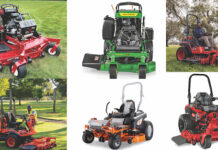Two major landscape equipment manufacturers are now taking connectivity to the production equipment we use every day.
Briggs & Stratton and Husqvarna have developed innovative systems to connect landscape company owners and managers with the real-time, in-the-field performance of their landscape and snow production equipment and, by extension, the employees who use it. And they do this without having someone on the ground supervising production.
Let’s start with InfoHub, the Internet of Things (IoT) device and web-based platform that Briggs & Stratton showcased at this past fall’s GIE+EXPO. Most simply, it’s a system that allows an owner or manager to track the location and usage of equipment in real time, any time via a website. But its capabilities extend way beyond equipment location and usage. The on-the-job data that it tracks and collects is fed from a cloud-based platform to the InfoHub portal, which can be instantly accessed.
The nature and the volume of the data, a function of its 75-plus platform features, greatly aids scheduling, job bidding and analysis, proof of service and equipment maintenance, says Jason Rives, general manager of Brake Landscape and Lawn Care in St. Louis, Missouri. Improving any of these operational functions benefits any company’s efficiency and profitability; improving on most or all of them is a huge win, he says.
A full season of InfoHub
Brake Landscaping and Lawn Care began using InfoHub this past May. It was one of 24 companies giving the Briggs & Stratton system its baptism under fire on clients’ properties during 2016 and 2017.
In Brake Landscaping’s case, a local Ferris dealer visited its headquarters and installed InfoHub on about 40 of its mowers in a single day. Installation takes minutes, says Rives, and it’s agnostic, meaning that InfoHub can be installed on any piece of gasoline-fueled equipment with a battery, regardless of size or color of the unit.
Rives says he grew to depend more and more on the system as this past mowing season progressed. He adds that as he became more familiar with the system, he also became more impressed with the value of the information it shared with him on its dashboard.

“At any given time, I can pull up the website and immediately see where every mower in our fleet is then and there. There is no lag time. I can see even what direction the mowers are moving and the patterns they are making,” says Rives, adding that being able to watch his firm’s equipment, and how it’s being used by employees from jobsite to jobsite in real time resulted in significant savings for his company in 2017.
Mowing margins improve
Rives says his company this past season more than doubled its budgeted 10 percent margin for mowing. He says the system provides visibility to profitability by jobs and by crew, making it much easier for a company like his to determine whether it is making money or losing money on each property or project.
Beyond that, the system is a great training tool, too. Rives appreciates being able to pull up the history of specific jobs and showing and explaining to employees how to do them more efficiently. In the end, the more efficient a company becomes, the more leverage it gains in pricing, bidding and selling work in its marketplace, he says.
“We had one crew finishing a job after 5 p.m. After we let them know about the program and made some suggestions to improve their performance, they began finishing the job about 3 p.m. and the quality was just as good. That crew wasn’t purposely messing around; they were just going up and beyond what the client expected of them,” recalls Rives.
Other savings result from not having to have a supervisor spending so much time on jobsites monitoring what everybody is doing and how they’re doing it, Rives says.
“If I didn’t get this installed when I did, I was going to hire another production manager to help out with the load. It’s definitely saving us management and supervisory time,” he adds.
After mowing season was over, Rives said he was investigating using it for snow services. Also, he plans, using the program’s route-optimization features, to streamline the process of scheduling more than 700 mowing jobs for spring 2018, a task that usually takes him weeks each off-season.
Husqvarna Fleet Services
Early in 2017, Husqvarna shared its Fleet Services system with the U.S. green media at its “Silent City North America” event in Miami, Florida. Fleet Services is a cloud-based system that connects its lawn services machines and their in-the-field operators directly to an online portal.
Three components make up the system — machine sensors (which work for gas and battery tools whether ride-on or handheld), a Wi-Fi base station and an operator tag. The sensor transmits the data to the cloud, which can be accessed via an online portal or a mobile application using the Fleet Services app.
The machine sensor is designed for Husqvarna commercial lawn equipment — ride-on mowers, walk-behind mowers, and commercial-grade trimmers, backpack blowers, hedge-trimmers and chainsaws. The system allows company owners and managers to see what their production equipment is doing on jobsites by capturing and recording precisely when equipment is on or off, how long it is on, when it is idling and when it is actually working, including what level of power is being used.
The data from each piece of equipment is uploaded to the cloud where you can access and review it via the dashboard on your computer or tablet. After data on machine usage and landscaping teams is collected, the intuitive software optimizes the process by sorting the information into the following categories:
- Workday log — reveals how productive the company really is, visualizing how much the whole fleet, or individual machines, are being used.
- Interactive maintenance system — keeps track of all machines and alerts both the service manager and Husqvarna dealer before maintenance intervals.
- Machine handling — Improves machine handling to prolong the life of the product, improve safe machine operation and reduce fatigue for crew members as well as boost efficiency and productivity.
- Vibration reports — focuses on improving the health and safety of operators in the field by helping them better understand and manage vibration levels. All power tools generate a certain level of movement.
- Library — continuously aims to arm both management and operators with practical, up-to-date insights and tools. This includes operator manuals, workshop manuals, parts lists, machine handling movies and tutorials.
- Business lead bank — landscaping teams can submit business leads from the field. Those business leads end up in a business lead bank, making it easier for landscapers to communicate the most cost-efficient way to improve maintenance levels on properties under their care.
- Individualized green care — allows managers to create the information around each property. Information can include tasks, dates, frequency, quality levels, location information and contact information.
Fleet Services has been in development and testing for several years, both in Europe and the U.S. Husqvarna is planning a limited launch in the second quarter of 2018. Pricing for Fleet Services, a subscription service, will be announced at product launch.
Read more:











![[VIDEO] Dickies®: Discover Workwear That’s Anything But Uniform](https://turfmagazine.com/wp-content/uploads/2023/06/1647663814-4b1a2a7742790a9b1e97a3b963477850192e1d6a9dfba9b07214a77bae25d6e3-d-218x150.jpg)





























![[VIDEO] Dickies®: Discover Workwear That’s Anything But Uniform](https://turfmagazine.com/wp-content/uploads/2023/06/1647663814-4b1a2a7742790a9b1e97a3b963477850192e1d6a9dfba9b07214a77bae25d6e3-d-324x160.jpg)